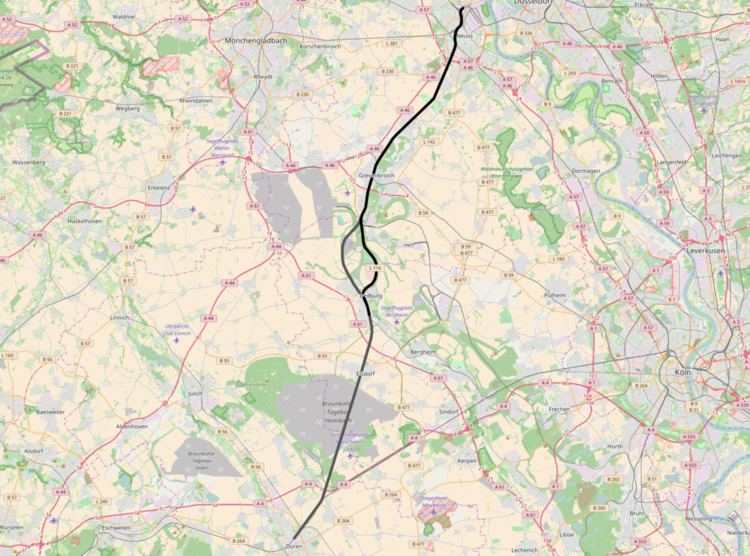Line length 49.0 km (30.4 mi) Line number 2580 | Route number 481 | |
 | ||
Number of tracks 2: Grevenbroich – Holzheim Track gauge 1,435 mm (4 ft 8 ⁄2 in) standard gauge Operating speed | ||
The Düren–Neuss railway is a line in the German state of North Rhine-Westphalia. The non-electrified main line originally ran from Düren to Neuss, but the Düren–Bedburg section has been closed and dismantled.
Contents
History
The Neuss–Duren section was opened by the Rhenish Railway Company (Rheinische Eisenbahn-Gesellschaft, RhE) on 1 September 1869.
On the morning of 5 September 1937, a serious railway accident occurred in Holzheim station: a special train running from Rommerskirchen with 800 pilgrims on pilgrimage to Kevelaer was derailed. 17 people died and 18 people were seriously injured.
Until the mid-1970s the line took another route between the stations of Gustorf and Bedburg, running through Harff station and Kaster halt. As a result of the development of the lignite mining works of Rheinischen Braunkohlewerke (Rheinbraun) at Harff, the line was relocated between Gustorf and Bedburg. Between the two stations was Neurath station, which was not a passenger station, but only an operations station, providing a place for trains to pass. Since the completion of the mining on the site of the old route it has been intended to return the line to the old route through Kaster. This project has not been implemented.
From 27 May 1995, passenger services were discontinued on the Bedburg–Duren section. On 31 December 1995, freight services ended on the section. The line was closed on 2 June 1996. The Düren–Elsdorf section was located in the area of today's Hambach open pit mine and was subsequently dredged for lignite. The Elsdorf–Bedburg section was initially used for freight traffic, but was later shut down due to lack of demand and dismantled.
As of 2 June 1991, trains ran through from Neuss to Horrem, continuing in the peak hour to Cologne. From 15 December 2002, the rail service was extended throughout the day to Cologne.
In March 2006, the line was between Grevenbroich and Neuss-Holzheim was converted to the new Ks-signals, controlled from the electronic siganalling centre in Duisburg. On 1 November 2007, the rest of the line was also connected to the electronic signalling centre. At the same time, all older level crossings were upgraded to the state of the art with flashing lights. The crossing at Bahnhofstraße in Holzheim had been equipped with a full barrier and a gatekeeper who visually checked whether the tracks were free of vehicles; this is now done with a radar scanner.
Operations
Between Neuss and Bedburg, the line is served by trains running between Düsseldorf Central Station (Hauptbahnhof) and Köln Messe/Deutz or Horrem as the Erft-Bahn service. The Regionalbahn service carries the number of RB 38.
Rolling stock
Before the 1990s, class 150 accumulator cars were operated on the line. In the 1990s, class 212 diesel locomotives and later class 215 and 218 locomotives were used together with Silberling carriages. In the late 1990s, the locomotive-hauled trains were replaced with class 628 diesel multiple units. In 2003, two and three carriage class 643 (Bombardier Talent) diesel multiple units was added; two carriage sets were used until the 2010/2011 timetable.
Currently RB 38 services are operated exclusively with class 628 diesel multiple units, mostly as coupled sets with four carriages. Single class 628 sets (two carriages) are used on the short shuttles between Düsseldorf/Neuss and Grevenbroich and between Bedburg and Horrem.
Outlook
In the 1990s, it was planned (as part of a network targeted for 2015) to extend the Rhine-Ruhr S-Bahn network from Horrem via Bedburg to Düsseldorf as line S 18. This meant that the line would be upgraded and electrified. Two new stations were planned at Neuss Polizeidirektion and Neuss Insel Hombroich.
The plans for the extension of the S-Bahn on the northern section of the line have not be pursued further by the Verkehrsverbund Rhein-Ruhr (VRR). The Zweckverband Nahverkehr Rheinland (Rhineland Local Transport Association, NVR) still plans to upgrade the southern section of the line by around 2020, including electrication and a flying junction in Horrem to connect to the existing S-Bahn line to Cologne. The NVR is pursuing the goal of relieving the Hohenzollern Bridge in Cologne by eliminating the RB 38 services. This would involve running line S 12 services over the Erft Railway from Horrem to Bedburg; the section of the S 12 from Horrem to Düren would be taken over by the line S 13. Under this plan RB 38 would run between Neuss and Bedburg. Subject to an agreement with the VRR, the S-Bahn service would later replace the Regionalbahn service to Grevenbroich.
Route
The line from Bedburg to Neuss Central Station (Hauptbahnhof) runs next to the Erft. The railway crosses the Erft twice between Bedburg and Gustorf. Over the Gustorf–Bedburg section, it flows over a longer distance almost parallel to the railway line. The line is mainly single track; it has two tracks only between Grevenbroich and Holzheim. From the crossing of the A57 autobahn, the line is single track again until shortly before Neuss station. In Grevenbroich station it crosses the Cologne–Mönchengladbach railway .
